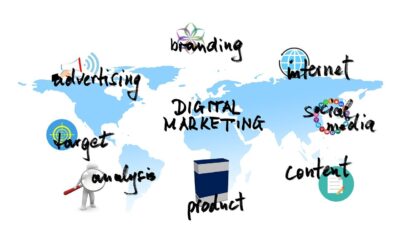14 Design Tips For Successful Websites
When it comes to design for websites, the first thing that comes to mind is the look of the web page, that is, if the site is “beautiful”. But website design goes far beyond appearance: today, it is a fundamental and strategic part when designing a professional website.

Visual aspects are of great importance, as good design conveys professionalism and credibility. But we must not forget that the design is also responsible for the user experience with the interface developed through functional, affective and behavioral aspects.
Therefore, investing in a website with an attractive and functional design is essential for your company to stand out solidly in the digital environment, conveying your message coherently and effectively. If you want to dominate the universe of digital marketing, you already know that you need to create a website to insert your business into the digital market.
And we are not talking about creating any website! The goal is to have an address that represents your company, attracts customers, increases brand visibility and helps you build an image of trust and authority with customers.
Providing a good browsing experience is essential to achieve better results with your website. To help you out, Xploited media listed here 14 important website design tips. Let’s start
You can approach web designing in many ways, just like any other activity. Today’s technology makes it possible to design complex and at the same time aesthetic and useful websites that are increasingly fulfilling their task – they provide information, visual and sound impressions, and even shock with their form.
1. Less is more
Your website design should prioritize what is important: it needs to be light and easy to interpret, so avoid a layout with a lot of distraction, visual pollution, unnecessary elements, and animations.
You only have a few seconds to catch the user’s attention, so using a simple, elegant, direct, and objective layout is the most recommended. With light pages, well-placed elements and smooth navigation, keep your focus on the important and relevant points of your market.
2. Pay attention to the information hierarchy
Planning is crucial for website design projects, and organizing all the content that will be present on the website hierarchically is part of that process.
To promote comprehension we can use a description of a book to exemplify this idea. It is in the overview that the reader identifies the topics covered in the research and it is important to arrange the details consistently and systematically to make the content understandable and relevant.
The hierarchy will guide the user when browsing your website. Therefore, it must be thought strategically, ensuring that the actions make sense and have a well-defined objective.
3. Apply your company’s visual identity
As with all other points of contact for your brand, you must also apply your company’s visual identity on the website. Remember that the visual identity system has as main objective to create a unity and a visual standardization, which facilitates communication and brand fixation by consumers.
Therefore, elements such as colors, typography, graphics, and your company logo must also be present on your website, creating a consistent visual pattern.
4. Make it easy to read
The user needs to consume the textual content of the website easily and comfortably. Thus, it is necessary to pay attention when choosing the sources of the texts.
The aim is generally to identify a standard typeface that will be used across the website. If you see the need to use more than one source, then add it only to highlight those details, such as titles or quotes.
In this way, the text looks cleaner and standardized, a factor that improves readability – that is, the ease with which the user can absorb all the textual content.
5. The website design must be responsive
A responsive website is a website that has a layout that perfectly adapts to the user’s screen size and resolution, automatically rearranges the content and provides a better browsing experience, especially on mobile devices such as tablets and smartphones.
Google itself also announced that searches via mobile devices have already surpassed desktop searches, and that responsive sites will have priority in search results. Based on this, today it is essential that design projects for websites include the factor responsiveness.
6. Use quality images on the website
As well as the identity, visual standardization, texts and other elements of your company ‘s website, the images must be of extreme quality, as they play an important role when it comes to attracting attention and attracting users to continue browsing the website.
Use images relevant to your company’s target audience and, if possible, invest in hiring a professional photographer to acquire original, exclusive and high-quality images. In case it is not possible, you can purchase some images in paid image banks.
As a last option, there are several free image banks on the internet. The only thing, however, is that the chance of more sites using the same images increases considerably.
7. Make navigation easier
Try to make navigation on your website as simple and as convenient as possible. Create a clear and concise main menu, use links during the text to complement the information strategically and aim as much as possible to suggest the direction the user will follow.
If the site has a forum, or if it’s a virtual shop, the categories and subcategories must be well structured to make it easier for people to find what they’re after.
Try to instill the curiosity of whoever is accessing the site and use “calls-to-action” (CTA), calls to action, either on action buttons with links or at the end of the texts to assist the user in making a decision.
In short, do not complicate!
8. Have an efficient search engine
A search field helps visitors to find what they are looking for more practically, because depending on what they need, the information may not be as prominent.
Make the search field visible throughout the site. It is also important that the search results appear well organized, so make sure that this tool, created to help and be functional, does not further hinder navigation and experience on the website.
9. Choose colors and fonts properly
The colors of your company’s website layout are the most subjective aspects of website creation. That’s because colors stimulate unconscious actions and feelings in people.
To define the website’s palette, first, think of your persona (target audience). There are differences between the choices for men and women since they see many more colors than they do.
Thus, if you want, for example, to win female users, aged between 14 and 16 years old and who like delicate and feminine products, brown and blue may not be good choices. Perhaps it is more interesting to think of pink or lilac – classic choices, and they are just because they work.
The meanings of colors are also different between world traditions, since white. Some trends appear to be worldwide, such as the use of red in the food business, as seen in the McDonald’s and Burger King logos.
In short: define your persona with as many attributes as you can (gender, location, culture, etc.) and think about it when choosing the colors of your company’s brand visual identity.
10. Develop a mobile version when creating a website
Having a responsive website is no longer a differentiator in the market – it is a primary obligation in a company. This is because, according to the Survey, 54.9% of users access the internet through mobile devices.
Details, such as the insertion of light, high-quality photos, layout with larger letters and synthesizing the content before the scroll bar, are essential for this action to be successful. Several Large companies adopted the strategy and increased their sales.
11. Pay attention to the user experience
The biggest concern that your company should have when creating a website is with a good user experience. Build a clear, objective and easy to navigate website. The user must know in advance what the shopping cart steps are, for example.
And information that is not designed for the public, should be easily instructed, as in the case of clicking on the Facebook button and accessing the company’s page on Facebook itself.
12. Create a visual hierarchy
Calling the reader’s attention to the main message you want to convey is one of the factors in the success of your business website traffic. So, concentrate the information you want to highlight in the upper left corner of the layout. The technical justification for this attitude is that people read from top to bottom and from left to right.
Create a website with a web design that has appropriate colors to communicate with your company’s persona, that can be read through different devices and that highlights the message you want to convey this is essential for the company’s presence in the digital world.
13. Watch out for the number of banners and ads
When developing website design, it is important to be careful not to include excessive banners and advertisements.
You need to have already accessed a website or gateway with a multitude of advertisements and banners for advertisement, right? Or worse, ads that “jump” on the computer, and open new tabs on your browser, significantly hinder the navigation. Situations like these are inconvenient for consumers and it’s not the best choice for your company to “drive” deals.
Therefore, always prioritize quality content. Insert the banners, handpicked, only in strategic locations on the website, so as not to hinder navigation or disturb users.
14. Make it easy to contact your company
- It is important that website visitors easily find your company’s contact information.
- To do this, you must have a complete contact page on the website, where the link is present in the main menu, and that includes all the means of contact that your company offers. Also include a form with few fields for the visitor to complete. If your business offers online quotes, create an exclusive page for that, with a longer form if necessary.
- You can also use the footer of the website to enter the main forms of contact, such as telephone and e-mail, as this way users can find this information on all pages of the website.
- Also take the opportunity to insert links to the social networks where your brand is present, expanding the possibilities of getting closer and connecting with users.
- Finally, keep in mind that you are not creating a website for yourself, but your company’s target audience. It is with these people that he should talk. Therefore, imagine yourself in the place of these users to analyze whether the information is well arranged and that there are no barriers to navigation.
- A good option is to ask other people to browse the site, including people who do not have much affinity with digital media, to see how they interact with the interface and the arrangement of the information contained on the site. Tests like this help to find blind spots on the website, which should be optimized in the final project.
- Technologies and good practices on the Internet are constantly changing, so don’t hesitate to establish a solid partnership with a serious and qualified company to provide all the support you need, both in website design and in the ongoing maintenance and optimization of the website.

Read more articles about marketing.
9 Game-Changing Strategies to Skyrocket Your SEO Performance
It’s no surprise that many businesses have started focusing on their online presence. That’s because the internet has created a new avenue for businesses to expand their reach and find new audiences. However, finding these results isn’t easy, especially for businesses...
How Lawyers Can Employ Marketers to Get More Clients
Newly, the world has become highly sensitive with the legal profession across the globe having many lawyers demanding similar clients. Essential in today’s market should, therefore, be marketing and establishing a unique image for the lawyer so that whenever a...
How to Leverage Digital Marketing to Attract B2B Clients in the Modern Sanitary Industry
The sanitary industry has seen rapid advancements, with businesses like Alsanit NL leading the charge in innovation. However, even the most cutting-edge products require effective digital strategies to connect with the right B2B clients. To thrive in this modern...
Discover the Benefits of Trade Show & Event Marketing
As we live in the digital era where the majority of our interactions have become virtual, face to face meetings is refreshing and powerful. Trade shows, in their own way, are a great breeding ground for a business to connect with current and potential customers as...
The Must-Dos for Brands Planning to Penetrate European Markets
Entering European markets offers considerable opportunities for brands seeking to expand their reach and drive growth, particularly through effective business strategies and understanding regulatory environments. This article examines the primary benefits of...
Why Top Platforms Are Crucial for Business Email Marketing
Marketing via email continues to dominate the world of marketing online and provides businesses with an unbeatable return on investment and access to their customers. However, the secret to unlocking its full potential is in the software that you choose. A good...
How Do Digital Marketing Agencies Help SAAS Companies Attract Customers?
Intro In the evolving realm of Software as a Service (SaaS), attracting and retaining customers is crucial, given the competition in the market that necessitates unique approaches for differentiation and visibility. Digital marketing agencies for SaaS play a...
Top 9 Reasons for Getting Marketing Assignment Help Online
In today’s fast-paced academic environment, marketing students face numerous challenges that can make it difficult to complete their assignments. The added pressure to achieve strong academic results only heightens this difficulty. In such situations, online marketing...
How to Choose the Perfect Custom Exhibit Design for Your Brand
Do you want to create strong memories at your upcoming trade show display? A custom exhibit design works best when it builds a brand experience that showcases your brand identity while keeping visitors truly engaged. Recent trade show statistics reveal a 15%...
How Digital Marketing Services Improve Lead Generation for B2B Companies
With growing interconnectivity, digital marketing services have emerged as a key influence to growth particularly in B2B markets. Outbound lead generation has evolved significantly from cold calling and direct mail campaigns and has embraced more contemporary and...
The Key to Accurate Campaign Tracking: Mastering UTM Naming Conventions
Introduction No one wants to waste time or budget on a strategy that doesn’t deliver. That is why, in digital marketing, data drives everything. However, without accurate tracking, you’re essentially flying blind, and here’s precisely where UTM parameters come...
Creating Visibility for Your Brand: The Guide to Hiring a Marketer for Your Business
Many businesses benefit from hiring a marketer because the right person can generate a lot of value for the company’s attempt at finding new consumers. The following guide will introduce you to a whole new avenue of business growth strategies that may benefit your...














0 Comments